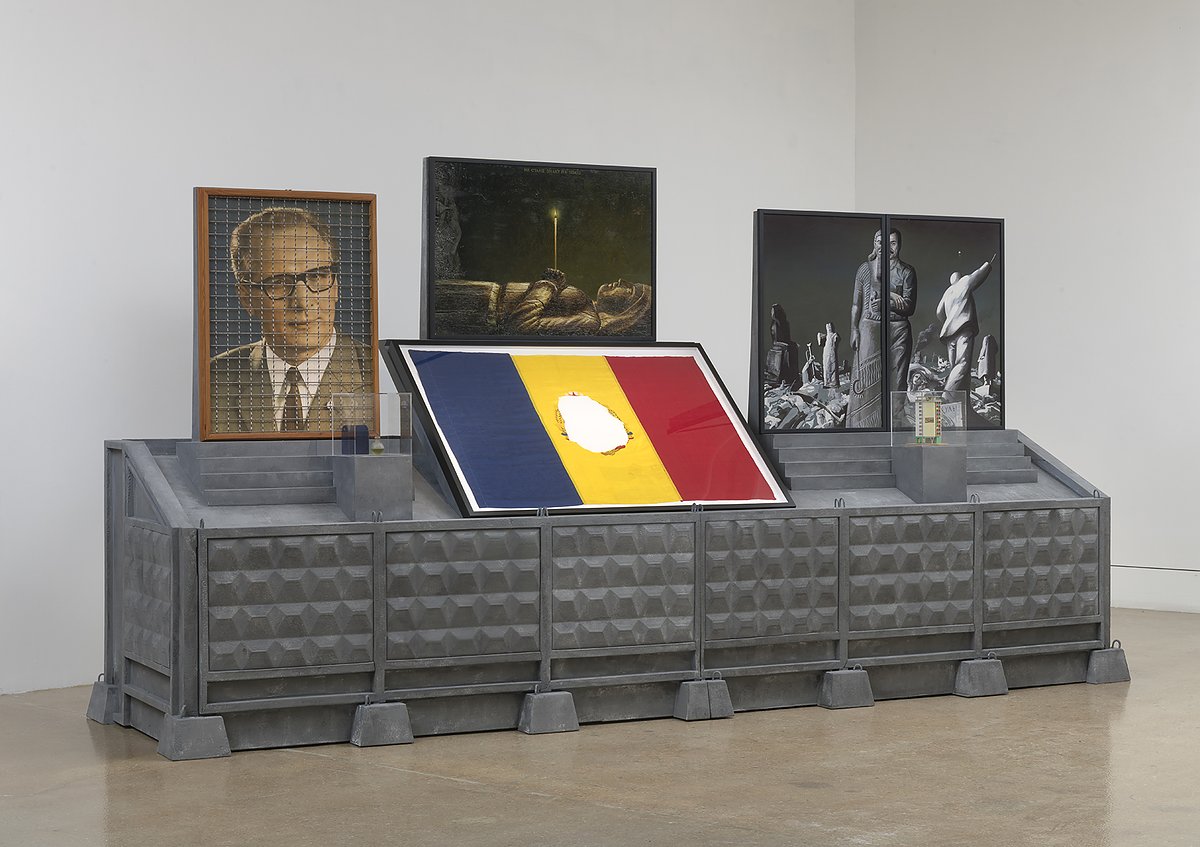
Regina Mamou, The Loop, 2022, steel, aluminum, birch, hard-coated EPS foam, acrylic, waterborne alkyd paint (pedestal); digitally-modified Soviet payphone (circa 1970s), cast iron, plastic, 8 audio tracks, 85 7/8 x 154 x 34 inches (pedestal), 12 ½ x 8 ½ x 4 3/8 inches (phone)
Front row (left)
Maker: Novaya Zarya
Title: To the Cosmos (perfume)
Year: Undated (likely commemorating the Vostok 1 spacecraft launch, April 12, 1961)
Location of Creation: Soviet Union
Materials: Glass, liquid (fragrance) (bottle); Felt, plastic, fabric, paper (box)
Dimensions: 2 ¾ x 2 inches (bottle); 4 ½ x 3 x 3 inches (box)
Collection: The Wende Museum of the Cold War, LA, California
Back Row (left)
Maker: Unknown
Title: Untitled (portrait of Erich Honecker with metal grate over the image)
Year: 1990
Location of Creation: East Germany
Materials: Paper, wood, metal
Dimensions: 36 5/8 x 27 9/16 x 1 9/16 inches (framed)
Collection: The Wende Museum of the Cold War, LA, California
Front row (center)
Maker: Unknown
Title: Cut Socialist Republic of Romania flag
Year: 1989
Location of Creation: Romania
Materials: Polyester
Dimensions: 39 ½ x 55 ½ inches (framed)
Collection: The Wende Museum of the Cold War, LA, California
Back row (center)
Artists: Yuri Panfilov and Andrei Vishnevski
Title: Leave No Trace on This Earth
Year: 1989
Location of Creation: Soviet Union
Materials: Tempera on fiberboard
Dimensions: Work can be oriented both horizontally and vertically; 28 ¾ x 41 ¾ inches (framed; horizontal); 41 ¾ x 28 ¾ inches (framed; vertical)
Collection: The Wende Museum of the Cold War, LA, California
Front row (right)
Maker: VEB VERO Olbernhau
Title: Plattenbau model
Year: 1970s
Location of Creation: East Germany
Materials: Plastic, paint, adhesive, paper, ink
Dimensions: 8 ½ x 5 ½ x 4 ½ inches
Collection: The Wende Museum of the Cold War, LA, California
Back row (right)
Artist: Aleksandr Vasil’evich Lozenko
Title: Oracles (left); Oracles No. 2 (right)
Year: 1991
Location of Creation: Soviet Union
Materials: Tempera on fiberboard
Dimensions: 36 ½ x 49 ½ inches (framed; total 2-paneled work); 36 ½ x 24 ¾ inches (framed; each)
Collection: The Wende Museum of the Cold War, LA, California
The Presence of the Past
Thursday, July 21, 2022
6:00 pm – 7:00 pm
Thursday, July 21, 2022
6:00 pm – 7:00 pm
Please join Bridge Projects in person for a conversation between Regina Mamou, featured artist in the group exhibition Here After, and Joes Segal, Chief Curator and Director of Programming at the Wende Museum of the Cold War in Los Angeles. Mamou and Segal will discuss Mamou’s work The Loop (2022), which incorporates objects from the Wende’s collection, the museum’s vision, and the important role of using contemporary art to respond to historical events.
Regina Mamou is the first artist-in-residence at The Wende Museum of the Cold War. In her current practice, Mamou is a research-based artist who focuses on the desire to understand the diversity of ideological systems. Her work is an amalgamation of fact and fiction, placing historical information together with falsehood to explore the power of belief systems, especially as it relates to communism and totalitarianism. This interest stems from her familial background where she grew up with the awareness of the implications of political ideology intertwined with religion. Mamou’s mother, who is Polish-American, and Mamou’s father, who is a Christian-Chaldean from Iraq, raised her multiculturally. As a former priest, Mamou’s father left the clergy, and Iraq, for fear of persecution. For this reason, she is interested in not only the examination of social utopias but also the struggle to create community through a dystopian future.
Joes Segal is the Chief Curator and Director of Programming at the Wende Museum of the Cold War in Los Angeles. Segal wrote Art and Politics: Between Purity and Propaganda, where he explores the position of art and artists under a number of different political regimes of the twentieth and twenty-first centuries, traveling around the world to consider how art and politics have interacted and influenced each other in different conditions.
The Wende is an art museum, historical archive of the Cold War, and center for creative community engagement that explores and inspires change.